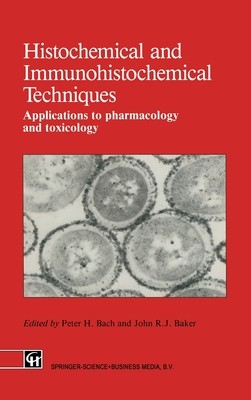
- We will send in 10–14 business days.
- Publisher: Chapman & Hall
- ISBN-10: 0412351005
- ISBN-13: 9780412351006
- Format: 15.2 x 22.9 x 1.8 cm, hardcover
- Language: English
- SAVE -10% with code: EXTRA
Histochemical and Immunohistochemical Techniques (e-book) (used book) | bookbook.eu
Reviews
Description
1 Why use histochemistry for a better understanding of pharmacology and toxicology?.- 2 Whole-body autoradiography of pharmaceuticals and chemicals.- 3 Image analysis, fluorescence and laser microscopy.- 4 The measurement of free calcium to assess cellular function and injury using digital imaging fluorescence microscopy.- 5 Flow cytometry to characterize normal and abnormal cell function.- 6 Quantitative histochemical and cytochemical assays.- 7 Fixation of tissue for histochemistry.- 8 Immunochemical methods to assess cellular malfunction.- 9 Cell markers and processes related to chemically induced carcinogenesis.- 10 The mechanistic basis of chemical- and drug-induced nephrotoxicity.- 11 Pollutant-induced toxicity in the marine environment.
EXTRA 10 % discount with code: EXTRA
The promotion ends in 19d.19:37:55
The discount code is valid when purchasing from 10 €. Discounts do not stack.
- Publisher: Chapman & Hall
- ISBN-10: 0412351005
- ISBN-13: 9780412351006
- Format: 15.2 x 22.9 x 1.8 cm, hardcover
- Language: English English
1 Why use histochemistry for a better understanding of pharmacology and toxicology?.- 2 Whole-body autoradiography of pharmaceuticals and chemicals.- 3 Image analysis, fluorescence and laser microscopy.- 4 The measurement of free calcium to assess cellular function and injury using digital imaging fluorescence microscopy.- 5 Flow cytometry to characterize normal and abnormal cell function.- 6 Quantitative histochemical and cytochemical assays.- 7 Fixation of tissue for histochemistry.- 8 Immunochemical methods to assess cellular malfunction.- 9 Cell markers and processes related to chemically induced carcinogenesis.- 10 The mechanistic basis of chemical- and drug-induced nephrotoxicity.- 11 Pollutant-induced toxicity in the marine environment.


Reviews